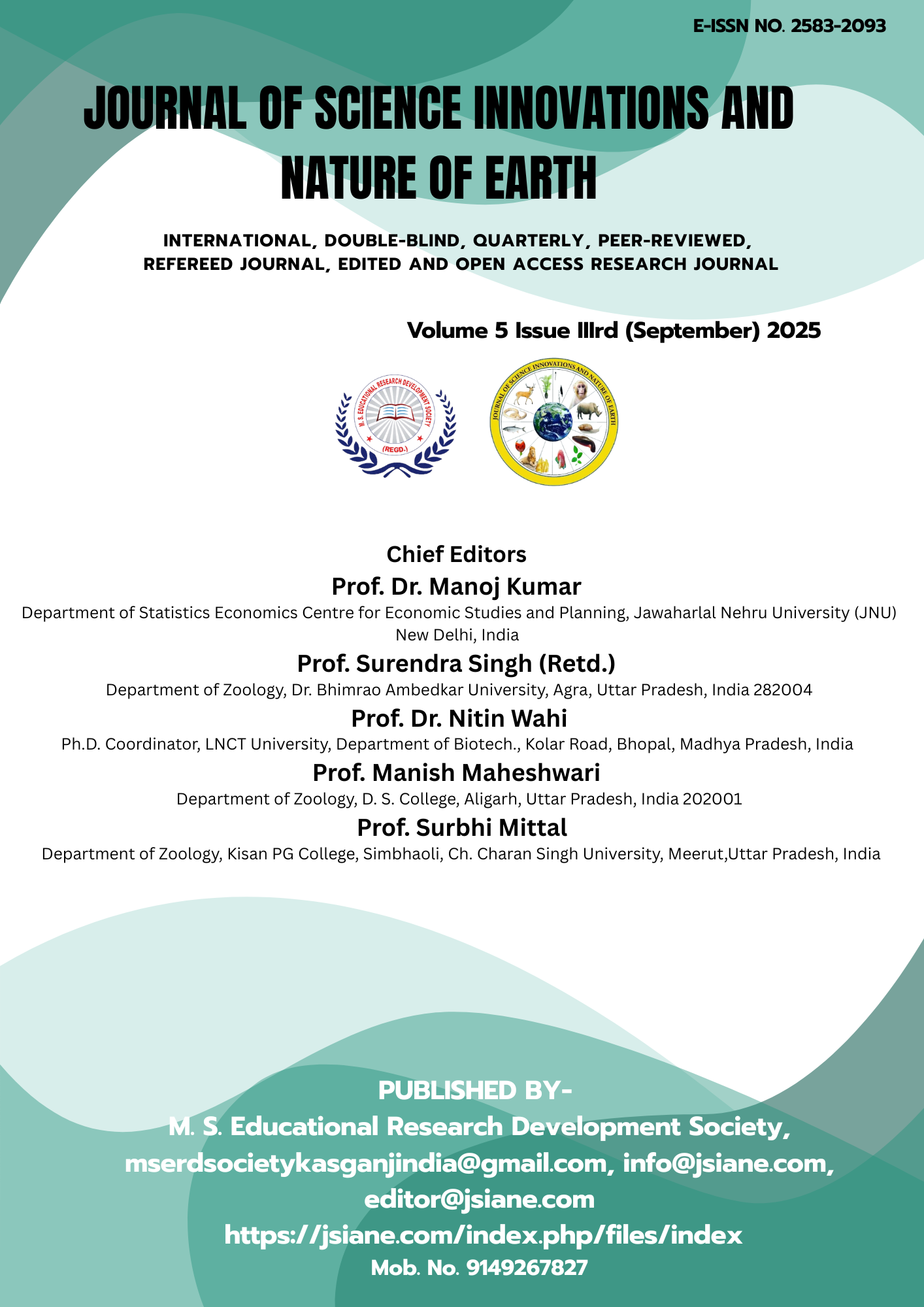Phytochemical screening of Datura metel L. extracts: A medicinal plant growing at Braj region of western Uttar Pradesh
DOI:
https://doi.org/10.59436/jsiane.419.2583-2093Keywords:
Aqueous, Datura metel, Ethanol, Medicinal plant, Phytochemicals, SolanaceaeAbstract
Plants are regarded as a chemical factory and a rich source of secondary metabolites because they contain a wide variety of beneficial chemical compounds. Medicinal plants offer a wide variety of bioactive chemicals, especially those belonging to the Solanaceae family. The major purpose of the current work was to analyze the phytochemical from the leaves, fruits, and stem extract of Datura metel and the existence of bioactive components using a range of phytochemical tests. D. metel, is a highly medicinal important, short-woody shrub plant from family Solanaceae growing at Braj region of western Uttar Pradesh. Disease free parts; leaves fruits & stem were collected, cleaned with tap water, dried in shade and coarsely powdered. Stem fractions were extracted by soxhlet extraction with acetone and water. Phytochemical analysis was examined in aqueous, ethanol, chloroform, petroleum ether and acetone extract. The significant result obtains in aqueous, ethanol, chloroform and acetone extracts of leaves, fruits and stem which was riches in alkaloids carbohydrates, glycosides, phenol, phytosteroids, flavones, terpenoids, cardioglycosides, sugar, amino acid & proteins. However, petroleum ether did not showe presence of carbohydrates, glycosides, phenol, tannins, anthraquinones, cardioglycosides, sugar, saponins, amino acid, & proteins. Chloroform extract also shows negative signal in anthraquinones, coumarins and quinones. The current study emphasizes the importance of investigating D. metel extract, which is rich source of bioactive phytochemicals and plays a significant role in its antifungal and antimicrobial properties, supporting its traditional medicinal uses and suggesting commercial applications in the pharmaceutical and nutraceutical industries, as well as further investigations for researcher.
References
Afroz M., Akter S., Ahmed A., Rouf R., Shilpi J.A., Tiralongo E., Sarker S.D., Goransson U., Uddin S.J. (2020). Ethnobotany and antimicrobial peptides from plants of the Solanaceae Family: An update and future prospects. Frontiers in Pharmacology, 11:565.
Archana A.M., Lokesha L.M.S., Hubballi M. (2023). Qualitative phytochemical analysis of Datura (Datura metel L). The Pharma innovation, 12(12): 4007-4009.
Ayoola G.A., Coker H.A.B., Adesegun S.A., Adepoju-Bello A.A., Obaweya K., Ezennia E. C., Atangbayila T.O. (2008). Phytochemical screening and antioxidant activities of some selected medicinal plants used for malaria therapy in Southwestern Nigeria. Tropical Journal of Pharmaceutical Research 7(3): 1019-1024.
Chowanski S., Adamski Z., Marciniak P., Rosinski G., Buyukguzel E., Buyukguzel K. (2016). A review of bioinsecticidal activity of Solanaceae Alkaloids. Toxins (Basel), 8:1-28.
Cragg G.M., Kingston D.G., Newman D.J. (2011). Anticancer agents from natural products. 2nd Edition, Boca Raton, CRC Press.
Debela A. (2002). Manual for phytochemical screening of medicinal plants. Ethiopian Health & Nutrition Research Institute. Addis Ababa. Ethiopia, 35-47.
Deepa M., Sugitha N., Mythili S., Sathiavelu A. (2014). Antioxidant activity and Phytochemical Analysis of Datura metel. International Journal of Drug Development & Research, 6: 280-258.
Donatus E.O., Ephraim C.L. (2009). Isolation, characterization and antibacterial activity of alkaloid from Datura metel L. leaves. African Journal of pharmacy and pharmacology, 5: 277-281.
Elango R. and Jadhav U. (2010) Phytochemical screening of Moringa oleifera using High Performance Thin Layer Chromatography. Plant Archives. 10(2): 749-751.
Elijah J.P., Asomadu, Onyedikachukwu R., Abonyi, Collins U., Nnedimkpa O.J., Okeke, Sunday E., Daniel U.O., Eze, Nwanneka E. (2020). Phytochemical and proximate analyses of the aqueous extracts of Datura stramonium seeds and leaves. Trends in Natural Products Research, 1(2): 99-108.
Jaber A., Al-Harakeh L., Ibrahim G., Cheble E. (2019). Phytochemical study and antioxidant activity of extract from the leaves of D. metel L. European Journal of Pharmaceutical and Medical Research, 6(8): 65-71.
Kankia H.I. (2014). Phytochemical analysis and antimicrobial activity of crude extract of Datura metel leaves. Archives of Applied Science Research, 6(6): 138-143.
Mahesh B. and Satish S. (2008). Antimicrobial activity of some important medicinal plant against plant and human pathogens. World Journal of Agriculture Science. 4(5): 839-843.
Mann A., Banso A., Clifford L.C. (2008). An antifungal property of crude plant extracts from Anogeissus leiocarpus & Terminalia avicennioides. Tanzania Journal of Health Research, 10(1): 34-38.
Muthusamy A., Punitha M., Beslin L.G. (2014). Phytochemical Screening of Datura metel L. and Its antimicrobial activity on selected human pathogens. International Journal of Bioassays, 3 (11): 3474-3478.
Okeke M.I., Iroegbu C.U., Eze E.N., Okoli A.S., Esimone C.O. (2001). Evaluation of extracts of the root of Londolphia owerrience for antibacterial activity. Journal of Ethnanopharmacology, 78: 119 -127.
Okwu D.E. (2004). Phytochemical and vitamin content of indigenous spices of South Eastern Nigeria. Journal of Sustain Agriculture and Environment, 6: 30-34.
Olmstead R.G. and Bohs L.A. (2006). Summary of molecular systematic research in Solanaceae: 1982-2006, VI International Solanaceae conference: Genomics meets biodiversity (Beljium: International Society for Horticultural Science (ISHS), 745, 255-268.
Reddy J., Tiwari R.S., Bohra M., Krishna T., Kumar S.B., Ashoka H. (2025). Quantitative and qualitative analysis of leaf and stem extracts of Datura metel. International Journal of Current Research and Review, 17(3): 6-10.
Saxena V.K. and Sharma R.N. (1999). Antimicrobial activity of essential oil of Lantana aculeata. Fitoterapia, 70(1): 59-60.
Sharma M., Singh V.K., Sharma M.M., Patil N., Jain M., Koushik P. (2025). Extensive assessment of Datura metel L. accessions: Geographical origins-based clustering coupled with morphological and phytochemical profiles to illuminate medicinal efficacy. South African Journal of Botany, 180: 358-368.
Taylor J.L.S., Rabe T., McGaw L.J., Jager A.K., Van Staden J. (2001). Towards the scientific validation of traditional medicinal plants. Plant Growth Regulator, 34(1): 23–37.

Downloads
Published
Issue
Section
License
Copyright (c) 2025 Maharaj Singh Educational Research Development Society

This work is licensed under a Creative Commons Attribution-NonCommercial 4.0 International License.









